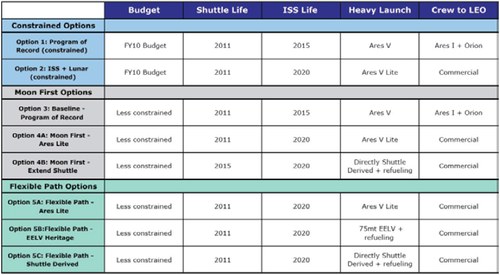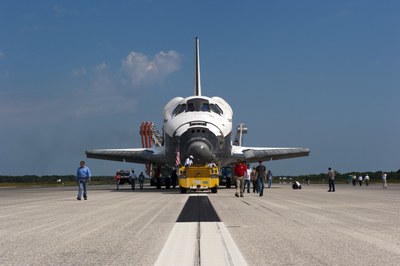The beginning of the end or the end of the beginning?Facing the shuttle’s demise and the futureby Roger Handberg
|
| Any future US civil manned space program will confront the open hostility of elements within the American electorate and in Congress. |
By 1969, as the Eagle landed on the lunar surface, President Richard Nixon, confronted by the Space Task Group’s proposal to pursue Apollo-style operations into the future, opted for the least expensive of the least expensive option, the Space Shuttle. The decisions were not overtly partisan: rather, presidents wished to wrap themselves in the American flag as it soared into space on various vehicles. President Nixon’s enthusiasm for the shuttle was one tempered by politics, as the earlier presidents had been. He did not wish to be known in history as the president who removed the US from manned space, a symbol of American achievement, but he did not see the costs as commensurate to the benefits except jobs in California in an election year (1972). Later, presidents Ford and Carter were not advocates of government-run space outside the scientific and developmental areas, as both saw the Space Shuttle as a vehicle that would be privatized once the technology was proven, spinning off the costs they inherited from President Nixon.
President Reagan came to office as the most supportive president aside from Lyndon Johnson regarding the manned spaceflight program; his support for the space station proposal (which would eventually become the International Space Station) provided the next step toward a continuing US presence in space. After the Challenger accident in 1986, President Reagan supported construction of a replacement shuttle; the accident ended most discussions of shuttle privatization due to cost and reliability questions. The George H.W. Bush administration pursued the ill-fated Space Exploration Initiative, which died of congressional indifference due to cost projections beyond the political will to support. But, by 1993, the crewed space flight program was careening toward disaster due to cost overruns in the space station and shuttle programs, which were growing at such a pace as to threaten to absorb the entire NASA budget. President Clinton supported continuation of the space station program but forced two changes: the shuttle fleet was now maintained by a new organization, the United Space Alliance, and the space station was transformed into the ISS with the Russian Federation as a partner with new cost constraints. In 1996, Clinton approved a follow-on program, the X-33, to eventually replace the shuttle with the completely-reusable VentureStar.
By 2001, the manned space program confronted financial Armageddon yet again with the George W. Bush administration moving to restructure the ISS program to a fiscally more manageable level and canceling the X-33. The latter fell due to developmental schedule issues and questions about whether its weight issues could be conquered sufficiently to produce a vehicle sufficiently large and robust enough for crewed flight operations. In the aftermath of the February 2003 Columbia accident, President Bush announced in January 2004 the Vision for Space Exploration (VSE) as the next step for the space program: the effort was to break away from low Earth orbit, back to the Moon, and then at some point on to Mars. The ISS was to be completed by 2010 with the space shuttle then retired. The closing down of the shuttle and, later, the ISS (VSE budget projections eliminated funding for the ISS as soon as 2015), was the device by which the new program could be funded without a massive budget increase. The savings would be absorbed into the developmental costs of the new program.
| At different points in its history, there were crises in terms of NASA’s future directions, but the debates were largely nonpartisan. |
The resulting Constellation program included new launch vehicles, the Ares 1 for crew launch and a later heavy lifter, the Ares 5, with the crew exploration vehicle, the Orion, being in appearance an Apollo capsule “on steroids”. The goal was a return to the Moon by 2018 where bases would be established to allow for long duration expeditions that could be, in principle, generalized to future operations on the Martian surface. Difficulties arose in Ares 1 development with delays in scheduled tests and the prospect of heightened costs. In a fashion, the objections to Ares 1 were a continuation of the objections that ended the X-33 program, schedule, and cost. President Obama’s forays into the space program confronted this ongoing debate over the Constellation program with its purported difficulties. In response, the Obama administration established a committee to examine the Constellation program and possible fixes or alternative routes forward. The Committee report in the fall of 2009 declared in effect the Constellation Program was undoable given existing budget projections along with technology issues. The committee suggested a “flexible path” approach might be more useful and doable under existing present and future fiscal constraints as this chart from the final report’s executive summary illustrations:
 |
The Committee’s report was partially rolled into the Obama administration’s approach to the question of future human missions by NASA. The showstopper became the fact that there was no consensus on what launch vehicle was required to continue human exploration of outer space. When the Apollo program went dark, there was the space shuttle coming along to ensure the future. Now, the result has been effectively a stalemate with powerful legislators imposing restrictions on NASA’s policy options going forward while protecting current employment by delaying the cancelation of the Constellation Program. The program effectively died, but the funding continued through several iterations of continuing resolutions to fund the federal government. In addition, NASA is prohibited from interacting with the Chinese, one of three nations to operate a human spaceflight program—now down to two programs, the Chinese and the Russians. A budget agreement was finally reached for FY2011 but that merely pushed NASA’s crisis forward into the FY2012 legislative wars, where the issues are broader and clearly more dangerous for NASA’s programs, especially new and controversial ones.
What has changed?
The brief historical overview above illustrates what one can call the critical point about NASA and the future of US civil government human spaceflight activities. At different points, there were crises in terms of NASA’s future directions but the debates were largely nonpartisan: one obvious example was President Clinton’s willingness to consider and push the space station program forward. The Space Station Freedom (at that time) was clearly seen as a Reagan Republican legacy program—possibly another “moondoggle” in the terminology of the 1960s regarding the Apollo program transposed forward. In the 1960s and early 1970s, Democratic legislators were generally more skeptical of space activities like Apollo given the dire social needs they felt would be better served by use of the money. The debate over supporting the space station (and by extension the shuttle, whose purpose was to support a space station) was one that split party lines with votes based on constituency interests and broader themes of national prestige and image. The recent Pew poll regarding public support for the US space program illustrates that long-standing split between Democrats and Republicans over the space program: Republicans are more likely support the program and see the space shuttle as a good economic investment. However, when the public, including Republicans, is asked to tradeoff between the space program and other priorities, the other priorities usually win out.
| If the debate over deficit reduction is real and entitlements (Social Security and Medicare/Medicaid) and defense spending are held harmless or largely protected from significant cuts, NASA’s problems make it an optimal target for severe budget reductions. |
The more recent events surrounding the US crewed spaceflight program cast the debate into a much more partisan and confrontational situation, which has the potential to make the space program less a center of national pride and prestige than one of partisan warfare. The intensity of the debate is fueled by several factors, including legislators’ fears about lost constituent jobs—fears that are compounded by broader concerns that there exists no foreseeable replacement for the Space Shuttle or any other launch vehicle. What is often forgotten is that the George W. Bush administration started the shuttle shutdown process and acknowledged there would be a gap before the Ares 1 came into service. The difficulty became that the gap grew even longer as Ares 1 problems delayed completion. More recently, NASA has suggested the amount of funding provided and proposed by Congress in future years is insufficient to successfully complete the heavy lifter project in any reasonable time frame. There also exists great hostility to proposed commercial flight options to low Earth orbit, the option suggested by the administration. Ironically, it’s a Democratic president who supports private enterprise for achieving Earth orbit, while Republican legislators support a government program.
All of this occurs against the background of an increasingly partisan congressional war over the federal government budget deficit, the federal debt ceiling, and the Obama healthcare plan that Republicans basically want to repeal. NASA is threatened by the first two disputes because the deficit reduction debate focuses mostly on discretionary spending where NASA represents a fairly large target with relatively weak support from a national constituency. Whether the first two issues can be resolved definitively this year remains an unknown (at the time of this writing in mid-July 2011) but if the debate over deficit reduction is real and entitlements (Social Security and Medicare/Medicaid) and defense spending are held harmless or largely protected from significant cuts, NASA’s problems make it an optimal target for severe budget reductions. Such reductions could render the entire debate over shuttle replacement a moot point; the private option would be the only game in town for the US. Except for legislators located immediately around NASA facilities, there is likely to be severe erosion of congressional support for NASA’s budget when measured against other national priorities.
That “vision thing” (the deficiency attributed to President George H.W. Bush) has been a long-standing problem in the US space program. Future directions have largely been destination driven (the Space Exploration Initiative and the Vision for Space Exploration, or the various space science missions in the solar system), an outgrowth of the concern with space “firsts” which characterized the early space race. Now, though, most of the obvious locations have been visited at least by robotic missions, so there is nothing under the sun that is completely new except for sending humans down the same trail. The problem is that there is no political will to drive such missions with their large and likely to escalate costs. The American political process at its best has difficulty with long-term government programs when the same program is revisited each fiscal year for the next budget allocation. With partisan animosity growing, NASA is being sucked into the whirlpool of congressional and presidential politics. The reality is that nothing of major significance is likely to happen until after the 2012 presidential and congressional elections.
Apollo was a pure and shining moment in US space history when there was national unity on the question of future directions for the US manned space program. That unity proved short-lived as budget issues arose in subsequent years but the differences were never so politically partisan as to endanger future directions for NASA. NASA was clearly supported for idealistic and very mundane political reasons: the Apollo program was a giant technological enterprise whose bounty was spread across numerous states and congressional districts, a technological TVA for the South. Now, in the absence of a viable national space objective, the process is reduced to partisan bickering and self-serving short-term choices. Slowly, the nonpartisan aura of the US human space program is dissipating, leaving a mix of bad feelings and distrust on all sides. How much damage will be done, no one knows.
